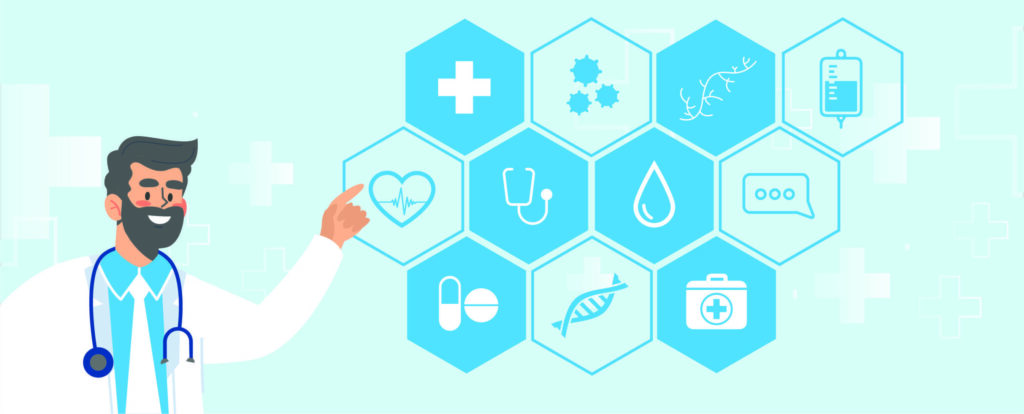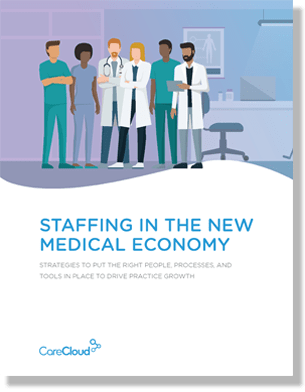CURRENT SITUATION
The past few years have seen a massive upgradation in the healthcare industry. Technology invaded healthcare and delivered an all-encompassing, next generation, wellness medium. Since 2019, tech companies applied their expertise to advance healthcare givers, while non-tech firms have acquired the skills to become emerging technology providers. From artificial intelligence (AI) to robotics and wearable data analytical control devices, healthcare has shifted from “patient unknown” to “patient know it all” status in no time.
“According to the HIMSS Future of Healthcare Report, 80% of healthcare providers plan to increase investment in technology and digital solutions over the next five years”
Forbes
HOW THE PANDEMIC BOOSTED THE DIGITALIZATION OF HEALTHCARE
Healthcare digitalization was long seen but has always faced rigidity. Many people believe the pandemic has done to healthcare what’s called “A blessing in disguise”. By forcing caregivers and patients to use digital healthcare delivery platforms, Covid-19 accelerated virtual care adoption. All this leads to up-scaled virtual care capabilities of both healthcare providers and patients.
This has also benefited physicians by shifting the care accountability to their patients. Add on, patients’ engagement levels boost, giving them security. All in all, a win-win situation in the care management factor for both.
MODERNIZING HEALTHCARE VIA DIGITAL TOOLS
Over the years, personalized digital health tools have transitioned the care paradigm into patient’s hands. Also, Medicare recently announced its revised ICD-10 and virtual health delivery codes. All of this, promoted “in-depth health improving care” rather than just “symptom control”.
Now, well-being is prioritized, and patient-centered off-site digital tools are one main factor in achieving this “true healthcare”.
While digital tools ease care delivery for physicians and satisfy patients more, they also showcase some challenges along the way. These challenges require eagle-eye view scrutiny and constant modification for a secure digital healthcare universe.
Here are some digital tools and how they optimize healthcare deliverables:
Telehealth
Automating the initial patient information inlet process has saved physicians trillions of useful minutes.
National Academy for Medicine predicts for a bright telehealth future quoting “When it is clinically appropriate to address health concerns without an exam or with good quality video or still images, telehealth can reduce delays for specialty consultations and primary care.”
Telehealth technology venders, like CareCloud, are already taking the next step by using AI chatbots aided by human-like language processing. This technology will gather targeted information specific to patient’s condition and convey to respective professionals. Thus, saving caregiver’s & patient’s precious time while providing future-corrective results.
Remote Patient Monitoring
During the first quarter of the pandemic, the percentage of healthcare professionals using remote consultation rose up to 45%.
What started with “virtual care wards” in many hospitals last year (through which patients were monitored by physicians via video monitoring and digital devices), might change to “virtual ER” in near future.
Also, studies suggest that remote monitoring through virtual ICUs will benefit many community hospitals to reach advanced care.
CareCloud is advancing the RPM system through its FDA-approved device integration, monthly and annual analytical reports, deep scrutiny of health KPIs, and managing red flags to minimize future critical patients. All this delivers timely treatment and preventive cures, so each physician’s patient has improved well-being.
Wearable Devices
It’s the Gen-Z era. Hence, despite facing difficulty, this sudden technological up-serge was rather taken flexibly by many tech-savvy populations. The new technology of wearable devices and real-time remote data monitoring has saved people’s time, cost, and care transparency.
Wearable technology will gather physiological health parameters like blood pressure, sugar levels, and hormone levels; all critical guessing the mental and physical well-being of a patient.
Facilitating Off-Site Patient Engagement
“The global patient engagement technology market is projected to reach USD 27.9 billion by 2027 from USD 17.3 billion in 2022”
MarketandMarketTM
Off-site patient data collection and supporting technology have boosted patient engagement immensely over the years. Also, application programming interfaces (API) provide patients access to their healthcare data. While physicians are optimizing this data for critical clinical decision-making, patients are receiving improved care and are highly satisfied. Hence, overall digital health infrastructure is advancing.
Medicare shifted towards value-based reimbursement models. In the future, care will be focused on improving patient’s well-being rather than just curing symptoms in hand. CareCloud holds a futuristic vision and designates an expert care team in its patient management system- Breeze.
FORESEEING THE FUTURE OF HEALTHCARE
Digital transformation has started shaping the future and the next 5 years will sharpen the color of the digital fruit healthcare is envisioning now. AI and cloud-based care delivery platforms will distribute care deep and wide through a screen tap.
The pandemic opened a way to higher patient engagement and satisfaction. Now patients deliver their care in collaboration with their physicians.
The AI-driven data collected from digital devices, including image data, and real-time physiological data can be utilized for high-level medical cures. Like communicable diseases, pandemics, genomics, and vaccinations. This technology driven healthcare can be life-saving for coming generations.
Health device real-time data + AI/ML-driven data = preventive medicine.
Actively and passively collected data can form a warning system for a futuristic preventive healthcare approach.
In the approaching years, predictive analytical data shall save communities. A data that can be filtered and analyzed by researchers to predict and cure illness factors even before they turn harmful.
At CareCloud, we are developing the technology for the next decade and would be honored to back your practice in advance.


